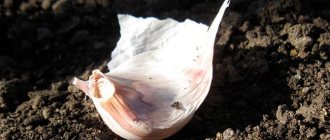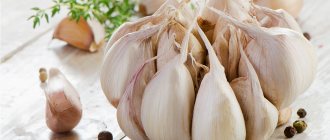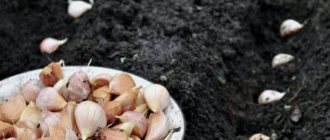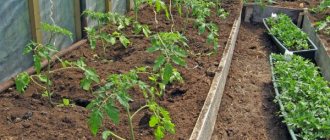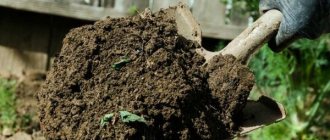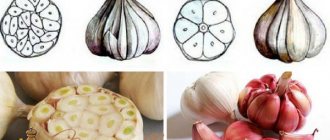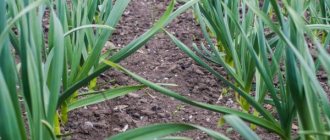Features of winter garlic
The crop is planted in open ground in the fall. Having formed a root mass in the autumn and safely overwintered, the plant grows vigorously in the spring. The development of winter crops is facilitated by moisture stored after snow melts.
Biological and agrotechnical features of winter garlic:
- high adaptability to different climatic conditions;
- high winter hardiness;
- roots germinate at 0 °C, and at 3-5 °C they grow intensively;
- demands on moisture, especially during leaf growth;
- root length – 10-20 cm;
- increased demands on soil fertility, the best option is light, slightly acidic and well-fertilized soils, sandy loam or loamy;
- the desired soil acidity is neutral or close to it;
- Garlic cannot be grown in one place for years; it cannot be grown again in the same place; it can only be planted after 3-4 years.
Winter garlic is a bulbous plant whose leaves and head repel pests - slugs, caterpillars, borers and even moles.
How does watering affect garlic yield?
Studies have shown that the difference in yield between irrigated and non-irrigated garlic is about 40%. In arid regions the difference is even higher - with drip irrigation it is approximately 70%. Due to the artificial irrigation system, optimal soil moisture is maintained, and nutrients in the form of solutions are delivered directly to the roots of the garlic.
Sometimes gardeners, getting carried away, water the garlic more than necessary. But excess moisture can cause irreparable harm to garlic plantings - waterlogging leads to rotting of the garlic heads.
Which variety of winter garlic to choose?
The main disadvantage of winter garlic is its poor keeping quality. Among the abundance of winter varieties, gardeners have long identified several priority ones. The choice of variety mainly depends on the yield, size and taste of the heads. Table 1 shows popular varieties of winter garlic.
Table 1
| Name | Short description |
| Komsomolets | Shoots arrows. The number of teeth in the head is from 6 to 13 pieces. The husk is pinkish in color. High frost resistance. |
| Local Danilovsky | Not a demanding variety. The head has from 6 to 11 cloves. |
| Gribovsky 60 | Shoots arrows. There are up to 11 cloves in an onion. The teeth are large. Early ripening variety. The taste is spicy. |
| Otradnensky | Tolerates low temperatures well. Great taste. The arrows must be cut off in time so as not to lose the harvest. The husk is pink, with a purple tint. There are 4-6 teeth in the head. |
| Anniversary Gribovsky | Mid-late variety. Head weight - up to 80 g. Purple husk. One head consists of 10-12 cloves. Shoots arrows. |
| Yubileiny 07 | Mid-season high-yielding variety. The heads are flat-rounded, white. Weight – 80 g. |
You can read more about these and other varieties of winter garlic in the next article.
Tips for growing garlic in large heads
Around the twentieth of June, garlic shoots out flower shoots, at the end of which aerial bulbs (bulbs) develop. Several of the most powerful arrows that appear first can be left for seed. The rest are gradually removed at the formation stage, when they are good as vitamin-rich greens for salads and canning.
Timely breaking out the arrows at the very base, from the axils of the leaves, increases the yield and allows you to grow large garlic.
Do I need to tie garlic after the shoots break? Practiced by some vegetable growers, tying the garlic arrows in a knot does not give anything, since the development of the arrows does not stop, and a good half of the nutrients do not enter the bulb.
Boarding time
Winter garlic is planted in late autumn. This must be done before the slush and cold weather. Planting dates depend on the specific climatic conditions of the region; their range is mid-September to late October. In the southern regions, you can plant garlic even in November, but in the north it is better to complete the planting work earlier - in early autumn.
In order not to make a mistake with planting, be guided by the local climate. Find out when stable frosts occur on the ground. Garlic should be planted 3-4 weeks before this period. During the time remaining before frost, the planting material - cloves or bulbs - takes root, but does not germinate.
The gardener talks in detail about growing winter garlic in his video below:
Selecting a location
Winter garlic is grown in all regions of the Russian Federation, including in the north. The culture is frost-resistant, so it safely survives winter temperatures.
Features of choosing a site for winter garlic:
- Good lighting.
- Waterlogged and swampy soils are not suitable - garlic will rot on them. Preference is given to elevated areas so that the site does not flood with melt or rainwater.
- Favorable predecessors are legumes, pumpkin, greens.
- The best soils are fertile sandy loams and loams.
- The best neighbors are berry crops. Garlic is planted near raspberries, strawberries, gooseberries, and also near flowers - it goes well with roses, tulips, daffodils, and gladioli.
Crop rotation rules
To prevent winter garlic from getting sick and produce high yields, consider the rules of crop rotation:
- The best predecessors are green manure. It is recommended to plant garlic after beans, oats, buckwheat, alfalfa, clover, mustard, and legumes. Among vegetables, cabbage, early potatoes, tomatoes, beets, peppers, and carrots are considered favorable predecessors. Areas where pumpkin crops grew are considered favorable for growth.
- Unfavorable predecessors are considered to be crops from the onion family, which suffer from the same diseases as winter garlic. These, in addition to onions and garlic, also include bulbous flowers.
Preparing for planting winter garlic
The agrotechnical cycle of growing winter garlic begins with the preparation of beds and planting material.
Beds for garlic
The procedure for preparing beds:
- The beds are prepared a month and a half before planting or in the summer.
- If the soil is heavy and clayey, river sand, sawdust and compost are added to it. Ultra-light sandy soils, on the contrary, require weighting - clay soil, compost and humus are added to them. If the soils are highly acidic, they are alkalized in advance by adding fluff lime, bone meal or dolomite meal.
- It is forbidden to introduce fresh organic matter - it contains a lot of ammonia. Nitrogen, stimulating leaf growth, will doom the garlic to freeze. It is best to fertilize the beds with peat manure compost or rotted mullein. For 1 sq. m bring 1-4 buckets. The soil is dug up along with organic fertilizers to the depth of a spade bayonet.
- Plantings are fertilized with superphosphate (30-40 g per 1 sq. m) and potassium salt (10-25 g per 1 sq. m). Instead of phosphorus-potassium fertilizers, soot or ash will do - 0.5-1 liters per 1 square meter. m beds.
The beds for winter garlic are located on the sunny side; they should be oriented from north to south. Before garlic is planted, the soil in the dug up beds must settle.
Planting material
First of all, the planting material is hardened. To do this, the selected heads are kept for 2-3 weeks in a cool place (3-5 °C). The further process of preparing planting material is determined by its type. There are two options for planting winter garlic:
- With teeth. The garlic is separated into cloves, and each one is carefully inspected. When separating the heads into cloves, it is important not to damage the husk. All small, diseased and damaged teeth are discarded. Teeth that are deformed or have cracks on the bottom are not suitable. The selected material is disinfected: In ash liquor. To prepare a solution, 400 g of ash is poured into 2 liters of water. Boil the solution for half an hour, cool and keep the teeth in it for 2 hours.
- In a solution of potassium permanganate (medium pink color) or copper sulfate 1%. Exposure time – 15 minutes.
For planting, take cloves with a diameter of at least 10 mm.
Watering methods
There are several methods for watering garlic, each of which has its own pros and cons. Among summer residents and gardeners, the manual watering method is often practiced; when growing large volumes, garlic is watered by sprinkling and drip method.
Manual irrigation
This is the most primitive method of watering, which does not require investment, but takes a lot of time and effort. If there are few beds, then the event can be perceived as a small physical exercise.
Pros of manual watering:
- low cost - no need to spend money on irrigation systems;
- no need to supply water to the beds;
- no dependence on electricity.
Minuses:
- greater physical stress on the gardener - if the plantings occupy a significant area;
- you have to move around the plantings, trampling down the rows;
- The amount of water poured out is not measured accurately.
Sprinkling
When sprinkling, water splashes like rain. Water falls on the plantings in the form of drops. To implement this method, special sprinkler systems are required.
Watch a video about watering garlic using the sprinkling method:
Pros:
- the method allows you to comply with irrigation norms;
- accurate and uniform distribution of moisture between plants is achieved;
- sprinkler systems are mobile;
- You can spray various substances along with water - for example, pesticides;
- the system does not interfere with soil cultivation.
Minuses:
- high water consumption;
- high cost of the system;
- the need for a lot of energy to create water pressure;
- wind affects the quality of watering;
- promoting the spread of diseases - due to the evaporation of moisture from the soil surface;
- if watering norms are exceeded, secondary salinization of the soil is possible - this will negatively affect the quality of garlic;
- low efficiency on heavy soils and in dry climates;
- there is a risk of negative effects on the leaves - sprinkling can provoke mineralization or disease.
Drip irrigation
There are two types of drip irrigation:
- superficial (ground);
- intrasoil (underground).
Surface drip irrigation system. Water is supplied through tubes with dropper dispensers directly to the plants. The tube system is laid out directly on the soil - in close proximity to the garlic.
Advantages of drip ground irrigation:
- less water consumption than with sprinkling;
- less moisture evaporation;
- you can use alternative irrigation schemes - small amounts of water at short intervals;
- there are no burns on the leaves from water drops.
Disadvantages of surface irrigation:
- it is necessary to replace watering tapes every 2-3 years;
- labor-intensive work when laying out, assembling and repairing tapes;
- clogged droppers.
Below is a video of drip irrigation of garlic:
Subsoil irrigation method. It is a stationary system designed for long-term use. The principle of its operation is practically no different from the functioning of the ground-based system, the only difference is in its location. Tubes with thickened walls are laid underground. In addition, emitters are used to prevent roots from entering the holes.
Advantages of subsurface irrigation:
- does not interfere with tillage;
- you don’t have to install and assemble the system every year;
- water and nutrients are delivered directly to the plant roots.
Disadvantages of subsurface irrigation:
- it is difficult to diagnose a breakdown of the emitter - a miniature dropper;
- difficulty of repair;
- high cost of the system - it is more expensive than ground-based.
The yield of garlic when using above-ground and underground drip irrigation systems is the same.
The optimal humidity level depends on the growth period of the garlic. The table shows approximate irrigation rates calculated for drip irrigation of winter garlic on medium loamy soils. Planting pattern – 60+20 x 6 cm.
| Development phase | Pre-irrigation humidity, % | Depth of control, cm | Average daily moisture consumption, cubic meters m per 1 ha | Irrigation norm, cubic meters m per 1 ha |
| Autumn | 70 | 25-30 | — | 65-80 |
| From germination to 3rd leaf | 80 | 15-20 | 7-16 | 35-40 |
| From 3rd to 5th leaf | 80 | 15-20 | 15-23 | 35-40 |
| From 5th to 8th leaf | 80 | 20-25 | 30-57 | 65-80 |
| From the appearance of arrows to the drying of leaves | 70 | 20-25 | 27-47 | 65-80 |
| From mass drying of leaves to harvest | 60 | 20-25 | 9-31 | 25-40 |
Step-by-step instructions for planting
Hardened and disinfected teeth are planted in the following order:
- The beds are loosened with rakes and furrows are made. The distance between adjacent furrows is 20-25 cm. Depth is 6-8 cm.
- The teeth are placed in the grooves at intervals of 6-8 cm. They are placed vertically - bottom down or on their side. The bulbs are planted more densely - only 15 cm are left between the furrows, and 2-3 cm between the bulbs themselves. They are buried 3-5 cm.
- The planting is watered and sprinkled with a layer of mulch. The thickness of compost, rotted straw, peat, humus or sawdust is 3-4 cm. Mulching enriches the soil with humus, mineral salts, and additionally insulates the planting. Read more about soil mulching here.
- In areas with winter temperatures below minus 25°C, it is advisable to insulate the plantings again - put spruce branches or branches on top. Such a shelter will contribute to the accumulation of snow, which will provide additional insulation.
Is it necessary to water garlic after planting before winter at different stages of plant development?
Why is garlic so popular? It's all about its chemical composition. The culture is useful for protein (6.5%), carbohydrates (26%). Garlic contains arsenic compounds and up to 20 mg of ascorbic acid.
When consumed raw, this spicy vegetable has a healing effect on the body. It has the strongest bactericidal properties. The teeth and young leaves are used as food.
Garlic is used for pickling vegetables, pickling, and mushrooms.
There are winter garlic (shooting and non-shooting) and spring garlic. The type of garlic determines the planting date. You can plant garlic in the fall, or wait until spring.
Garlic is grown by experienced vegetable growers, but novice gardeners have too many questions about planting the crop.
They need to know how and when to plant garlic, whether it is necessary to water garlic after planting before winter, how to care for the seedlings.
Garlic varieties
Before planting garlic, you need to choose a suitable variety of garlic. There are many varieties, all of them adapted for growing in a particular area. When choosing, you need to take into account the climatic conditions of the region and the characteristics of the variety.
- Gribovsky-60. A shooting winter variety of hot garlic. Produces large bulbs with up to 11 cloves. The scales are reddish-purple.
- Gribovsky anniversary. A shooting variety of hot garlic. The bulbs reach a weight of up to 40 grams. The scales are bright purple.
- Komsomolets. A shooting winter variety of hot garlic. The bulb turns out to be large with pink scales.
- Danilovsky local. Non-shooting winter variety. It has a large bulb with 6-11 cloves, purple scales.
- Otradnensky. This variety of hot garlic is characterized by increased frost resistance. The bulb is large, it has from 4 to 6 cloves.
Growing rules
When planting in autumn, you need to follow certain rules that will allow you to do everything correctly and get a rich harvest. You can grow garlic using cloves and bulbs.
In the first case, the harvest of garlic heads will be obtained the next year, and in the second, the bulbs will make excellent planting material, and the harvest can be harvested in another year.
But it will be of higher quality, the bulbs will be of the same variety, larger.
Preparing the beds and soil
Winter garlic loves fertile loamy neutral soils. You should not plant garlic in the place where onions grew. Onions and garlic are the worst predecessor crops. They can infect the crop with dangerous diseases. It is better if, before planting garlic, legumes, cabbage, pumpkin, grain crops or greens grew in the garden bed.
You may be interested in: Caring for peonies in the fall, preparing for winter
Before planting garlic, you need to start preparing the bed in August. The place for it should be the sunniest and driest. When digging the soil, it is necessary to add a glass of lime, a tablespoon of nitrophoska and superphosphate. For each square meter, we recommend adding a bucket of compost or humus.
If the soil is very heavy clay, dense and not fertile, you need to add a bucket of peat to it. Loamy soils are added to peat lands.
Sandy soils are also not suitable for planting garlic for the winter; they need to be filled with peat, a bucket of clay soil, and fertilizers. Digging should be carried out to a depth of at least 20 centimeters. A solution of copper sulfate is introduced.
There is no need to compact the soil in the garden bed; just level it with a rake. The bed is left for a month so that the soil settles by itself. Cover with film.
Preparation
When planting winter garlic, you need to select and prepare planting material. To do this, take healthy, dry bulbs. Each is divided into cloves; damaged cloves are immediately removed. For planting, you need large teeth without traces of pest damage, completely protected by scales.
Large and medium-sized teeth are placed in a solution of table salt and kept there for 2 minutes. After this, transfer to a solution of copper sulfate for 60 seconds. Cloves should be planted on the beds without rinsing with water. There is another method: the planting material is soaked in a light-colored solution of potassium permanganate for 30-60 minutes.
Landing dates
It is necessary to plant winter garlic forty days before a strong cold snap. The plant must have time to take root and form a root system. It should penetrate deep to a depth of 10-12 centimeters.
The first leaves must not be allowed to appear on the plant, otherwise the seedlings will die. In the northern regions, cloves should be planted in the second or third ten days of September. In the Krasnodar Territory, in the Stavropol Territory, you can start planting on October 15.
Garlic may germinate if planted too early, or die if planted too late.
Planting scheme
For planting, it is necessary to make grooves 6-8 cm deep. There should be a distance of about 25 cm between the grooves. The cloves are planted in the ground bottom down to a depth of about 5 cm. The grooves are sprinkled with earth without compacting it.
After a few weeks, when it starts to get colder, you need to pour a 2 cm layer of humus or peat onto the beds. This will help insulate the beds. If weather forecasters predict a frosty winter, mulching is necessary.
Pour 2-3 cm of sawdust; they can be removed in the spring.
Growing garlic from bulbs
Winter garlic produces flower shoots in June. Aerial bulbs develop from them. They are collected when the wrapper bursts and the bulbs themselves change color. Before sowing, aerial bulbs are sorted, and the largest ones are used for planting.
Plant the bulbs 5 centimeters deep; you don’t need to stick them in too hard to avoid damaging them. In the summer, a single clove will grow from the bulb, which will become an excellent material for getting a large head of garlic from it next year.
Watering before and during planting
Should I water garlic in the fall? This question concerns most amateur gardeners. You need to look at the weather conditions. If there is no rain for several days after planting and no rain is forecast, you can lightly irrigate the bed. There's no point in getting carried away. If the weather forecast predicts rain soon, you shouldn’t waste time watering the garlic; in the fall, the garden is already full of worries.
Garlic should be watered when planting only in arid areas where rainfall is rare and soil moisture is insufficient. When planting garlic in the fall, the cloves should wake up and the root system should be well established in the soil. Watering will help fill the voids and ensure that the soil adheres tightly to the clove.
Experts do not recommend planting garlic in too dry weather. This is a big test for the crop, and winter planting itself will take a lot of effort. If the phytosanitary conditions on the site are not very good, the crops often get sick, you need to water the beds with biofungicides before planting.
To prevent contamination of the crop, you need to water the plot with a solution of Fitosporin-M. You can sprinkle the plantings with compost prepared with EM crops. Impregnating the soil with useful fertilizers is useful even when the soil is loose and the beds are organic. If there has been heavy rain after planting, the beds must be sprinkled with fallen leaves. This will help protect the plant from frostbite.
Watering winter garlic in spring
Should I water garlic in the spring? At the beginning of spring, the snow begins to melt, satisfying the garlic's need for water. Additional soil irrigation is not required. Garlic is moistened by meltwater and then by the first spring rains. During the period of leaf growth, sufficient soil moisture is necessary. This period for winter garlic occurs in April.
If there is little rain in the spring, the beds need to be watered once every ten days. Moistening is carried out to the depth of the roots. Moisture must penetrate to a depth of at least 30 cm. More often in the middle zone of the country, garlic is not watered because there is enough precipitation.
If it is necessary to water the plant with nitrogen fertilizer, fertilizing is carried out after scheduled watering or instead of it. When the bulbs begin to form, another feeding is carried out with an infusion of wood ash.
If the soil is very heavy or clayey, loosening the soil is necessary after watering. This will help prevent the bed from forming a soil crust and increase the porosity of the soil.
With such soil, loosening should be carried out after each rainfall.
The underground part of garlic begins to form in early summer. During this period, garlic experiences maximum need for water. It is necessary to water the garlic once every five days if it is hot without rain. If a dry strong wind is added to the heat, the soil must be moistened more often, every three to four days.
If it rains frequently, there is no need to water the garlic. If precipitation occurs too often or is heavy, you need to think about drainage grooves to prevent moisture stagnation. In lowlands, watering should be abandoned; the amount of loosening can be increased.
Cleaning
Harvesting winter garlic begins in late July - early August. Shooting varieties indicate that the harvest time is approaching because the inflorescence wrapper is cracking. If the arrows have been cut, complete yellowing of the leaves will indicate that the heads are formed. It is impossible to be late with collection, the covering scales will begin to burst, the head will disintegrate into cloves. Garlic will not be stored.
When harvesting, you need to carefully dig up the plant with a pitchfork, pull it out of the ground, and leave it in the open sun for 12 days. Then the garlic is transferred to a drying room.
Source: https://ProPosadki.ru/ovoshhi/chesnok/nuzhno-li-polivat-chesnok-posle-posadki-pod-zimu
Care and cultivation
Caring for winter garlic begins in early spring and lasts until harvesting. In the northern regions, garlic ripens in the last ten days of July, in others - earlier.
in spring
Caring for winter garlic in spring:
- As soon as the snow melts, the spruce branches or branches, if they were used as shelter, are removed. And there is no need to remove the layer of fine mulch and organic matter - soon green sprouts will appear from under it. Winter garlic is the first green in the garden. Sprouts emerge in March-April.
- When the greens appear, the garlic is fertilized with nitrogen. Two weeks after emergence, the plantings are watered with a solution of urea, ammonium nitrate or nitroammophos (per 10 l - 20 g). After 2 weeks - re-feeding.
- During the growing season, the beds are regularly weeded and loosened to a depth of 3 cm.
- Water the plantings every 5-7 days.
In summer
Caring for winter garlic continues in the summer:
- In June, a third feeding is carried out to support the plants during the formation of heads. Phosphorus and potassium are added by watering the beds with an ash solution. It is prepared by steeping a glass of ash in a bucket of water for three days. You can also add a solution of potassium monophosphate (per 10 l - 20 g), superphosphate (per 10 l - 25 g) or potassium nitrate (per 10 l - 15 g).
- Garlic plantations continue to be watered in summer with the same frequency as in spring. In hot weather, the frequency of watering increases. Three weeks before harvesting, watering is stopped.
- After each watering, it is advisable to loosen the soil.
- When the arrows reach 15 cm in length - for arrowing varieties of garlic - they are broken out. This is necessary to prevent the waste of nutrients on peduncles.
Is it necessary to water garlic when planting in the fall and other watering rules
Novice gardeners often worry whether they need to water garlic when planting in the fall, because excessive moisture can destroy the cloves. In general, this culture is special; it does not tolerate excessive watering, and at the same time it grows very shallow roots. Therefore, it would be nice to figure out how often to water garlic in open ground in order to have a stable harvest.
Is it necessary to water garlic when planting in the fall and other features of watering at different stages of the growing season?
Almost every gardener sets aside one or two beds for garlic. If agricultural techniques are followed, the bulbs ripen on time, and the yield pleases from year to year. One of the main measures for caring for a garlic plantation is the organization of watering.
The root system of the plant is located in the upper fertile layer of soil, drawing nutrients and moisture from it. This is why abundant but infrequent watering is so necessary for garlic. In its absence, the bulbs grow small, and the number of cloves in them increases.
How to properly water garlic at different times of plant development?
Whether you need to water garlic after planting in the fall depends on weather conditions. If heavy rain is predicted in the next 2-3 days after planting the cloves, then you should not waste time on irrigation - there is already enough autumn work in the garden.
If the weather is clear, then, of course, to ensure the rooting of winter garlic, you need to water the bed - the cloves must not only wake up, but also be well anchored by the roots in the soil, otherwise they will be squeezed to the surface and freeze. Watering after planting also ensures that the soil adheres tightly to the cloves, filling the voids.
Of course, you should not plant teeth in a dry bed - this is both labor intensive and a test for the crop. But what to water the beds with before planting garlic depends on the phytosanitary conditions of the site. Where it often gets sick—it turns yellow and shrivels untimely—you can disinfect the soil with biofungicides or etch the teeth with them.
We try to get ahead of troubles, so we always water the plot with a solution of Fitosporin-M, although we sprinkle the plantings with mature compost prepared with EM crops.
Note that even in organic beds where the soil structure is loose, it is a good idea to saturate the soil with beneficial microbes.
After heavy rains, we sprinkle the plantings with fallen leaves; such mulch reliably protects them from frostbite.
In March - early April, winter garlic is fully provided with moisture due to soil moistening with melt water and the first spring rains. Spring varieties in the middle zone are sown in April - early May in well-moistened soil.
Seedlings experience a moderate need for water at the beginning of the growing season, when the leaf apparatus is rapidly growing. For winter varieties, this period occurs in April, and for spring varieties, in May.
If the spring is dry, then the beds need to be watered several times at intervals of 7-10 days, making sure that moistening occurs to the depth of the root layer (up to 30 cm). If there is precipitation, typical for this time of year in the middle zone, the garlic plantation is not watered at all.
If it is necessary to apply fertilizing (at the beginning of growth, plants require nitrogen, so the bed is watered with chicken droppings and/or weed infusion), they are supplemented after scheduled watering. During the formation of the bulbs, experienced summer residents carry out another feeding, drenching the plantation with an infusion of wood ash.
Where the soil is dense and mulch is not used, after watering it is necessary to loosen the soil surface to a depth of 3 cm. This is necessary not only to increase the porosity of the soil, but also to prevent the formation of a soil crust, especially in areas with clay soil. It is advisable to carry out loosening after every heavy rain.
Garlic experiences its maximum need for moisture while the bulbs are forming. Winter garlic grows underground at the beginning of summer, and spring garlic, starting at the end of June.
If the weather is dry and hot, then the plantings are watered once every 5 days. During abnormal heat, which sometimes occurs in the first half of summer, especially if there is a strong wind (dry winds), the soil in the beds should be moistened once every 3-4 days.
During rainy periods, garlic should not be watered. During heavy rainfall, care should be taken to dig drainage grooves in the beds to prevent stagnation of moisture, to which the plant reacts negatively.
When growing garlic in areas located in lowlands, watering is also undesirable. It is best to increase the amount of loosening to increase moisture and air permeability of the soil, or build raised beds.
Watering at the end of the growing season
Watering should be stopped three weeks before the planned digging of the bulbs. However, there is a nuance.
If you plan to use the bulbs in the near future, for example, in summer conservation, then the plantation is watered longer, and the last moistening is carried out a week before harvesting.
The presence of moisture in the soil makes the heads more juicy, but at the same time their keeping quality decreases.
And if you are growing garlic for long-term storage (for the whole winter and spring), then the amount of watering during the formation of the bulbs is reduced, and the last moistening is carried out a month before harvesting. Such heads have a smaller volume due to the minimal amount of water in the pulp, but their shelf life increases significantly.
For example, well-dried winter garlic, when stored cold at a temperature of 0...+2°C in a well-ventilated room, can remain fresh until March, and spring garlic can last until next June.
In any case, water the garlic plantation based on weather conditions and the characteristics of plant development in the current season. Check the weather forecast and listen to your intuition when determining whether to water garlic when planting in the fall, or consult with more experienced vegetable growers.
Source: https://ekosad-vsem.ru/nado-li-polivat-chesnok-pri-posadke-osenyu/
What pests can you encounter?
The most dangerous diseases of winter garlic are rot and rust. Bacterial infections usually infect garlic during storage and then penetrate into the soil with planting material. Table 2 presents common diseases of winter garlic and methods of combating them.
table 2
| Pests/diseases | Harm/symptoms | How to fight? |
| Penicillium rot of the bottom | The leaves turn yellow and then die. | In case of penicillosis, harvesting is carried out when the garlic is completely ready. When trimming, the neck is left longer - about 10 cm. The heads are well dried. Store at a humidity of no more than 75%. Note! Garlic leaves may turn yellow for other reasons, which are discussed here. Then the methods of dealing with this phenomenon will be different. |
| Rust | Rusty spots appear on the leaves. | Spray the planting with fungicides - Oksikhom 0.4%, Ridomil 0.2% or others. Repeat the treatment 2-3 times with an interval of 1-2 weeks. |
| Downy mildew | Gray spots appear on shoots and inflorescences. | The plant should be fed on time. For prevention, calendula is planted near the beds. Treatment with Ridomil. |
| Stem nematode | Thread-like worms 1.5 mm long feed on plant juices. Capable of completely destroying a culture. Lines appear on the leaves, feathers dry out and die, and a rotten smell appears. | Spray with Calypso according to the instructions for the product. |
| Onion fly | Fly larvae damage garlic feathers, slowing down growth and yield. | Spray with a solution of shag (250 g) and hot pepper (1 tbsp.). The ingredients are poured into 2 liters of hot water. They insist for 3 days. After straining, bring to 10 liters, and pour in 30 g of liquid soap. |
Diseases and pests
Winter garlic is susceptible to a large number of diseases, including white and bacterial rot, bottom rot, fusarium, and black mold. How to grow vegetables to avoid such problems?
In order to prevent garlic from mass infection, a number of preventive manipulations are carried out:
- the soil selected for growing the crop is sprayed with industrial fungicides in accordance with the instructions. Also, a Bordeaux mixture solution with a concentration of no more than 1% is used as a protective agent.
A mixture of potassium permanganate, vitriol and boric acid helps a lot - add 1 g of the first two substances and 0.2 g of acid to 1 liter of water;
- The seeds are treated with disinfectants (Fitosporin, Maxim). Instead, you can use a one percent solution of potassium permanganate. The cloves or seeds should be in the container for 15-25 minutes.
The winter garlic crop is affected by onion fly and stem nematode - small worms that settle on the leaves and bulb of the plant.
You can get rid of onion flies using a concentrated salt solution: add 200 g of regular table salt to 10 liters of water. Soon after spraying the larvae die.
Getting rid of the second pest is much more difficult, since it is very tenacious and lives in the underground part of the plant. Their attack is revealed by the appearance of the plant: the leaf plates acquire a light green color and gradually curl into a pipe; rot forms on the head, which provokes its destruction.
It is almost impossible to drive away such insects, so it is better to try to avoid damage. Nematodes damage garlic much less if it was soaked for 2-3 hours in water heated to +45C before planting. Also, an excellent pest prevention is to soak the cloves or seeds in a 3% salt solution for half an hour.
After worms are discovered on a plot, it is not used for growing garlic and onion crops for 4 years. In order to repel pests, marigolds and calendula are sown near the area where garlic grows.
Cleaning and storage
To get healthy and fresh garlic, it is important to harvest on time. Once the heads are kept in the ground, they will lose their marketable quality - the outer scales will begin to crack.
Harvesting procedure:
- Start digging up the crop as soon as the lower leaves turn yellow and the tops fall en masse. Garlic is harvested in dry weather. They dig up and pull out of the ground.
- Do not remove the dug up garlic immediately - it must lie in the beds for several days to dry under the sun. The garlic dries along with the stem. If it rains, you will have to move the crop under a canopy, and there it will dry for about 5 days.
- Trim the stems of dried garlic. The length of the stumps is 4-7 cm. Dry the heads in a well-ventilated area or under a canopy.
Read the article about when and how to remove winter garlic from the garden.
If you store garlic in braids, do not trim the stems. If in bunches, leave the stem length 20 cm.
To determine when garlic is ripe, leave a couple of garlic arrows on shoots of varieties. When cracks appear on the shell of the spherical inflorescences, you can safely pull out the garlic.
Garlic, properly harvested and dried, is well stored - it does not spoil or rot. It can be kept under a canopy until the coldest weather, then it is transferred to baskets. The optimal storage temperature is 2-4°C.
Reviews
★★★★★
Alevtina M., Vladimir region. We have been growing the winter variety Komsomolets for several years.
Very productive and stores well. True, we go through it regularly. There are few bad heads. The taste is excellent, good fresh, in dishes, we also use it for preservation. It tolerates frosty winters without problems, and always grows large. ★★★★★
Boris T., Kirov region. I plant Gribovsky before winter.
I bury it deeply into the ground - 15 cm, so that it can better survive the frosts. If in the middle zone a depth of 5 cm is enough, then with our frosts this cannot be done. I make sure to leave a few arrows so that I can see when the garlic is ready. The heads grow large, fragrant, and are easy to clean for pickles and preservation. Hide
Add your review
Growing winter garlic does not require special care or investment, so it can become a profitable business even for beginning farmers. This undemanding and frost-resistant crop can be grown in the northernmost regions.
0
0
Copy link
